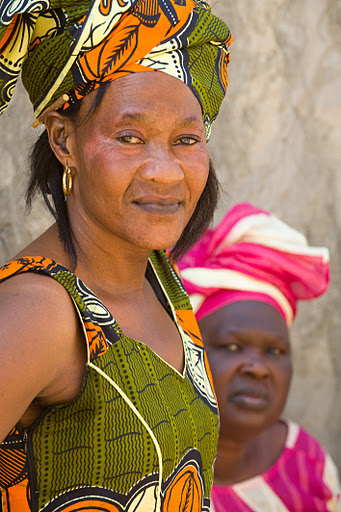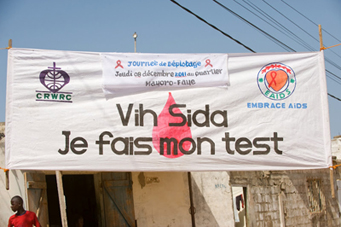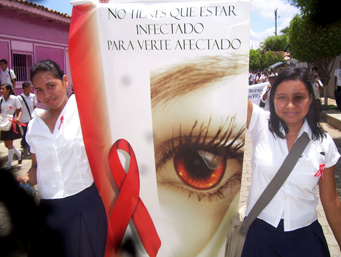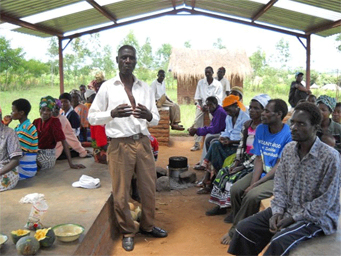|
|
In December 2011, hundreds of men and women gathered together and waited in line to be tested for HIV at an event organized by CRWRC and a local church and women’s group in Dakar, Senegal. This is just one of many examples of how the Church worldwide has become engaged in the fight against HIV and AIDS.
Yet, it wasn’t always this way. Only two decades ago, many churches shied away from talking about the disease and shunned those who were sick and dying. Changing this mindset has been a key part of CRWRC’s ministry.
It started with a few key staff members.
“In the 1980’s, I was living in the Dominican Republic (DR). At that time, HIV and AIDS was already becoming a public health issue – particularly in the gay and intravenous drug user populations,” recalls former staff-member Peter Vander Meulen. “The DR had become a center for regional dissemination due to the fact that it was a significant vacation destination for the US gay population. My wife, Peggy, was working for the Peace Corps at that time as a Medical Officer. She, like anyone familiar with public health principles, recognized two things: first, that HIV was not inherently a gay disease. It would soon be an epidemic among the general population. Second, that because of the way that HIV was spread and the time it took to kill, it would explode rapidly wherever it got traction.”
Vander Meulen and his family moved from the DR to West Africa in 1989. It was then that he met Wyva Hasselblad, who was working for the Global AIDS Programme (GPA) of the World Health Organization.
“I was visiting Senegal in 1988 with a view of potentially moving CRWRC’s West Africa regional office there,” he said. “Someone directed me to Wyva as a person who might be available to assist CRWRC with getting settled in the capital city and getting government registration. I called her out of the blue and introduced myself. She invited me to her house, fed me supper, and we talked a great deal. I found her to be extremely experienced and knowledgeable, especially in the field of health and HIV and AIDS. I left a day or two later with clear decisions to move the West Africa regional office to Dakar and to ask Wyva to be CRWRC’s program director in Senegal.”
With Vander Meulen’s encouragement and support, Hasselblad crafted one of the first CRWRC HIV and AIDS programs, but it wasn’t easy.
“The Church was comfortable saying that HIV was a viral disease that people contracted through their sinful behavior. This gave them an excuse to turn their backs on the many complex issues that are the root causes of the epidemic,” said Hasselblad. “In my first experiences with CRWRC in Senegal I learned that the churches there were unwilling to become involved. At the same time, I began to hear stories from church members who were fearful of their HIV status becoming known.”
For example, a young woman and her family approached Hasselblad and told her that she had been raped, but had decided not to make a public issue of the attack. When she and her fiancé planned their wedding, the church elders insisted that they both be tested for HIV. Her test came back HIV-positive. She and her family told the elders about the rape, but they did not believe her. The elders announced her HIV status to the church, refused to perform the marriage, and informed her that she could no longer be an active member of the congregation.
In the absence of willing church partners, Vander Meulen and Hasselblad collaborated with two influential Senegalese women’s organizations – the Society for Women and AIDS in Africa (SWAA) and Femmes, Développement, Enterprise en Afrique (FDEA). Together with these partners, CRWRC worked intensively with 29 women’s groups and nine youth groups from 1993 through 1997. This was funded by the United States Agency for International Development (USAID).
As part of this program, they developed resources such as puzzles, slideshows, card games, drama scripts, videos, and books that talked about AIDS, sexually transmitted infections, female genital mutilation, violence against women, and other sensitive issues. They held community events where drama and song were used to disseminate information and combat myths. They also trained community residents, who in turn educated others.
Other CRWRC staff around the world also began to address HIV and AIDS during these years. In Uganda, for example, CRWRC began working with the Uganda Protestant Medical Bureau in 1992 to address the issue of HIV and AIDS with churches in the country. And in Kenya, CRWRC worked with the Anglican Church of Kenya to produce “Facing AIDS” study materials for churches, which were later used by more than 1,000 churches across East Africa. The learning and resources from these early programs had a multiplier effect as community partners learned how to initiate and implement effective prevention and care programs.
These programs also paved the way for churches to get involved in HIV programming. Because these early programs started with an emphasis on changing “at risk” behaviors, churches had a pathway to involvement with which they were comfortable. As churches began to be involved in behavior change programs, however, they also started to recognize issues of systemic injustice that need to be addressed in the fight against AIDS.
“The impact of AIDS on the Church has been significant. It forced church leadership to learn more and get engaged in dealing with the problem,” said Davis Omanyo, who joined CRWRC in 2000 as its first full-time HIV/AIDS Program Coordinator and now serves as CRWRC Team Leader for the East Africa region. “As their knowledge about the virus increased, they began to recognize how it affects people in all aspects of life and how churches worldwide could be used to strategically fight the spread of this disease.”
Through strong support from churches and individuals in North America, CRWRC raised over $3 million for new AIDS programs from 2007-2010. As a result of the availability of funding, every CRWRC region developed highly effective AIDS programs to fit their context. In Asia, Latin America, East Africa, Southern Africa, and West Africa CRWRC has led the way in developing innovative approaches that have enabled the Church to be in the forefront of efforts to combat AIDS. Today, CRWRC has an “innovation fund” which continues to encourage CRWRC partners to test new approaches to targeting HIV in their countries.
“I haven’t ever had the courage to say this before,” one pastor recently shared with Hasselblad. “When I first started hearing about AIDS, I heard that it was a disease for people who are not living a godly life. I was scornful of those who became sick because it was as though God had marked them for their sinfulness. Along with everyone else in my village, I never wanted to hear that someone had died of AIDS as I might be asked to perform a Christian burial, and I felt I could not do that.
“Then my own brother came home to us, dying. We began learning about the illness — how hard it is to get treatment. While other illnesses can be treated, AIDS is very difficult and expensive to treat. We shared his fear that everyone would judge him and judge the rest of the family as well. We learned that he needed 24-hour care, and how much suffering he went through. It was a painful experience. I could no longer think of people with AIDS in the same way. But I still did not have the courage to admit that my brother died of AIDS.
“Along with everyone else, we did not say how he died — just that it was a long illness. But I can’t live anymore with that dishonesty. It is as though I am rejecting my brother. So now, I say that my brother died of AIDS. I loved him. He was a kind and gentle man and our family misses him. Now I want to honor him by learning to care for others so that they do not have to go through that emotional distress. Thank you, and thank CRWRC, for giving me courage to tell you this.”
Thanks to CRWRC programs, many churches are speaking openly about AIDS and how it can be prevented. They are encouraging members to be tested, discouraging stigma within the community, and bringing people together to provide support to those living with the disease.
“Deliberate learning and acceptance of the realities of AIDS has changed the thinking of those within the Church,” Omanyo said. “Helping the Church recognize the role it could play in fighting the epidemic has been a major success of CRWRC over the past 20 years. Combining that success with improved access to anti-retroviral medication has allowed us to see light at the end of the tunnel.”
In Senegal, for example, churches are no longer using HIV testing as a way to label and stigmatize people. Instead, testing is being encouraged as a way to build community well-being and overall health.
At the December 2011 event mentioned earlier, a young woman came bringing her fiancé.
“He said it wasn’t necessary,” she told Hasselblad, ‘but I told him that I had learned (in the CRWRC partnership program with the church) that everyone has to be tested – it’s the norm. It’s the responsible thing to do. So he came. ”
No longer seeking to blame and censure, the church is deeply engaged in establishing a new norm for herself, and for communities around the world.




